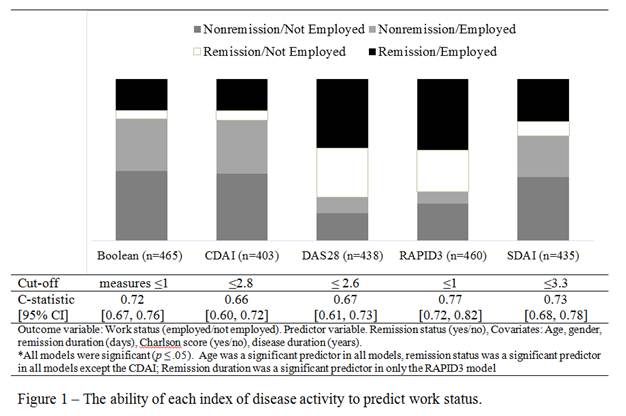Background/Purpose: Disease remission is the goal of treat-to-target initiatives in rheumatoid arthritis (RA). There are multiple indices to measure disease activity and remission status including those recommended by ACR and EULAR in 2011: the Simplified Disease Activity Index (SDAI) and a Boolean based definition (tender joint count, swollen joint count, C-reactive protein, patient global assessment ≤ 1). The choice of these measures was based on their predictive validity for radiographic damage and the Health Assessment Questionnaire (HAQ), outcomes which are focused on impairment and activity levels. Remission scores should be predictive of community participation, such as employment. As work disability is common for people with RA, it is particularly important that indices can accurately predict work status. This study evaluated each of five common indices of disease activity (Boolean, SDAI, Clinical Disease Activity Index [CDAI], Disease Active Score-28 joint count [DAS28], Routine Assessment of Patient Index 3 [RAPID3]) to identify the best predictor of work status.
Methods: In this cross-sectional study we extracted data on 511 working aged (≤65 year old) RA patients from the Rheumatoid Arthritis Comparative Effectiveness Research (RACER) longitudinal registry based at the University of Pittsburgh. This registry, started in 2010 has enrolled 1,045 RA patients with over 7000 usual care clinic visits. Work status and index data are collected at most visits and we selected the most recent visit that contained information on both. Patients self-identified as “employed” were coded as such; all other categories were coded as not employed. We calculated the Boolean, SDAI, CDAI, DAS28, and RAPID3 scores and coded each patient as in remission/not in remission based on published cut-off scores (Figure 1). We completed 5 separate logistic regressions with work status as the outcome and each index as the predictor variable. Covariates were age, gender, remission duration, disease duration and the presence of any comorbidities (yes/no) measured through the Charlson score, which we dichotomized. We report the C-statistic, which is equivalent to the area under a ROC curve and allows us to judge how well each model discriminated between employed and not employed.
Results and Conclusion: In all models except CDAI, remission status was significantly associated with work status. While all models were moderately good at predicting work status (C-statistic range 0.66 to 0.77), the RAPID3 was the most accurate and the DAS28 and CDAI were the least. A score indicating remission on the RAPID3 would correctly identity that someone would or would not be employed 77% of the time. This superior accuracy may be related to the functional questions included in this index, whereas all other indices rely on symptoms and patient assessment of health without a functional component.
Disclosure:
N. A. Baker,
None;
H. Eng,
None;
J. Feng,
None;
J. Lyons,
None;
Y. G. Hwang,
None;
K. P. Liang,
None;
L. W. Moreland,
None.
« Back to 2014 ACR/ARHP Annual Meeting
ACR Meeting Abstracts - https://acrabstracts.org/abstract/measuring-rheumatoid-arthritis-remission-which-index-of-disease-activity-best-predicts-work-status/

